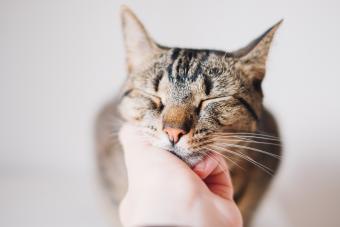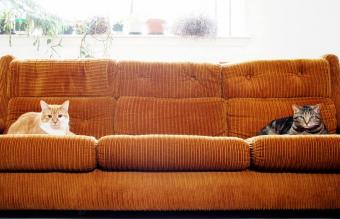
In the cat world, there’s a pretty fine line between playing and fighting. Kittens instinctively “play-fight” as a way to practice their hunting and combat skills (even if they don’t really need them as lazy house cats). But that can make it really difficult to figure out if your cat is playing or fighting with you or even their housemates. Use this guide to recognize the common behaviors associated with each, so you can discern between the two.
How to Tell if Your Cat Is Playing or Fighting With You
All cats play in different ways. If your previous cat was super gentle, yet your new cat bites you and purrs at the same time, it’s understandable to wonder what the deal is. Are they playing or fighting?
| Playing | Fighting | |
|---|---|---|
| Vocalizations |
Quiet sounds:
|
Louder sounds:
|
| Body Language |
|
|
| Claws |
|
|
| Fur |
|
|
| Eyes |
|
|
| Mouth |
|
|
Vocalizations
Associated Applied Animal Behaviorist Katenna Jones says that sound is a good way to tell if cats are playing or fighting. "If it's quiet, it's most likely play. If there's growling, it's most likely not."
If there's nothing other than the occasional meow or chirp, this means your cat is probably just playing. But if you hear stressed or aggressive sounds, like yowls, hissing, or screaming, you definitely have a fighter on your hands.
Body Language
A cat's body language is a pretty good indication of whether they're playing. Stiff body language usually means that a cat is stressed and not happy. Their back will also be arched, and their tail will either be pressed against them or moving in a fast, rapid, and stiff motion.
Their ears will also appear flat and back against their head. On the other hand, if their body language appears loose and in a normal, relaxed position, they are likely playing.
Claws
Kittens learn to retract their claws when they're playing so they don't hurt their littermates. Still, every once in a while, a claw might unintentionally catch you during play. But during a fight, cats are not afraid to use their claws to protect themselves. If your cat's nails are out and visible, there's a good chance they're fighting instead of playing.
Make sure your cat's nails are trimmed regularly to keep them from accidentally scratching you while you're playing.
Fur
During play, a cat's fur will look normal and lay flat against their back. However, when fighting, their fur will stand straight up, which is known as piloerection. This most commonly happens to the fur along their back and on their tail.
Eyes
Cats stare for many reasons, including when they're frightened and when they're excited. You can see dilated pupils during both playing and fighting, but if a cat is ready to fight, they're more likely to engage in what looks like a starting contest.
Mouth
In addition to the sounds coming out of your cat's mouth, you'll want to look at their mouth too. When your cat is playing with you, they won't outwardly show their teeth. They might lick your hand or, if they're overstimulated, they might try to bite you.
On the other hand, an aggressive cat will bare their teeth, usually while hissing or growling. A cat in this state won't hesitate to bite if they feel threatened.
"Playful" Biting and Scratching

Younger cats and kittens can have a tendency to bite when playing with their owners or during a grooming and cuddling session. There are a few reasons for these love bites.
- Cats who missed out on early socialization with their littermates may not have learned how to moderate their bite during play and can hurt a person or cat without intending to.
- Kittens who also are taught to play inappropriately by their owners, often unwittingly, can end up learning to bite during play because of their early roughhousing with humans. Again, these are cats who are not intending to hurt you and have simply learned bad play skills.
- Finally, some cats will bite during play or cuddling sessions because they simply become overstimulated and will nip or scratch as a way of saying, "enough!"
Biting should not be a part of playtime. If your cat tries to bite you during play, it's your job to teach them how to play gently.
Signs Your Cats Are Playing or Fighting
Playtime is a healthy behavior for kittens and adult cats. However, sometimes play can escalate if one or both cats become overstimulated or startled. Other times, you may see two cats fighting where it's clear they were aggressive with each other from the start. You can use the same types of behavior cues for you and your cat playing vs. fighting when it's two cats in the equation, with one addition.
Taking Turns
A clear sign cats are playing is that they will "take turns" being the lead in wrestling or chasing games. They may also separate for a few seconds and then start up again.
You know when cats are fighting because a cat that is involved in a fight will either continue fighting to defend itself or attempt to run away and hide to get free of the more aggressive cat. If you notice during play that one cat is always the chaser, this may be cause for concern. But if the other cat seems willing to engage, then just keep an eye on them to make sure both cats are having fun.
If you have any concern at all about your cats fighting, always supervise their interactions and intervene before a fight breaks out. This is safest for all involved and will keep the cats and you from being injured.
Dealing With Cat Fights
If it's clear to you that your cats are actually fighting or a cat is directing aggression toward you, there are a few important rules to follow. Safety is key when dealing with aggressive cats, as it's very easy to get clawed or bitten yourself.

1. Hands Off
Never stick your hands in between or around two cats that are fighting. The speed and intensity at which they are moving will almost inevitably end up with your hands getting scratched and/or bitten.
2. Use Noise
Make a loud noise to startle the cats to break them up, such as knocking two pots together, clapping your hands, or saying "HEY!" in a loud, sharp tone. If you anticipate that a fight might happen, keep something on hand in your home that makes noise, like an air horn or a party noisemaker.
Some cats will startle at the sound of a compressed air can commonly used to clean computers. Whatever you choose to use, do not continually use it. Instead, make a short, sharp noise that is strong enough to startle them both into stopping the fight.
3. Separate the Cats Safely
Once the cats have separated, you can throw a towel or blanket over one or both of them to split them up. Or try to shoo one into another room or to a safe space like up a cat tree.
You can also try to place a barrier between them, such as a baby gate or a large sturdy couch pillow. It's best to continue this separation by keeping them in different rooms behind closed doors so they can cool off.

4. Do Not Punish
Dealing with fighting cats can be a very stressful — and sometimes traumatic — experience. It's natural to feel the need to punish them, but avoid using any type of punishment.
Your goal is to get the cats separated as quickly and as safely as possible. Punishment will only increase their negative associations with each other, and very possibly with you. That will cause more damage to the behavior problem in the long run.
Understanding Cat Play and Fighting Behavior
If you're not familiar with cats' play-fighting, it's understandable that you might worry that they're actually fighting. Some cats can get quite enthusiastic during play fighting, either with you or their littermates. As long as there's minimal noise, their body language looks relaxed and normal, and no one appears to be getting hurt, you can enjoy seeing cats having fun with each other. As soon as you see any signs of aggression, intervene quickly and safely to break up the catfight.







